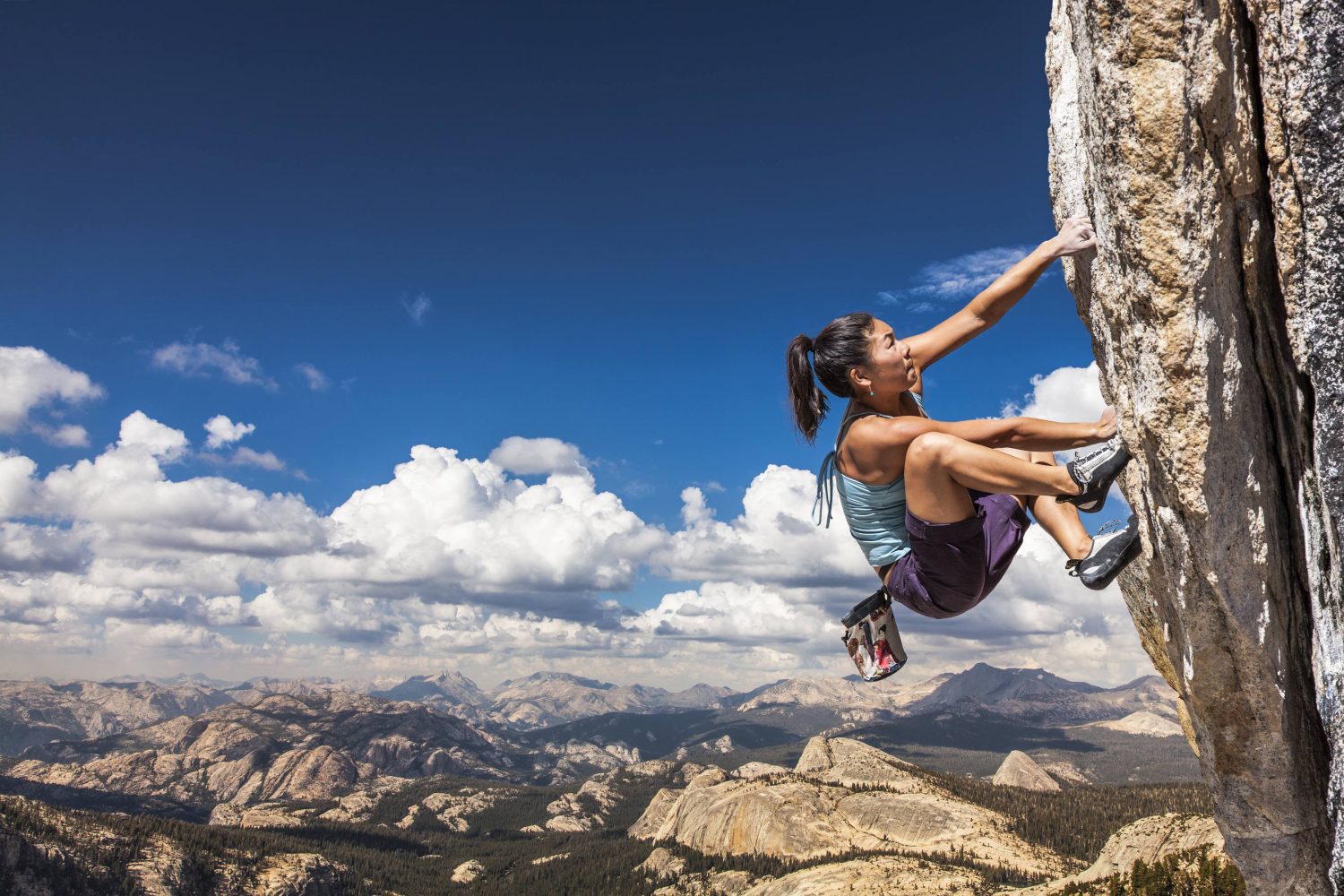Even though it brings its share of daredevils, rock climbing can be appreciated by legions of routine adventurers. If you are reasonably healthy and get yourself appropriate equipment and education, you, too, can develop into a rock jock.
Follow the following steps to Begin rock climbing:
- Locate an Experienced guide
- Describe the Kind of scaling you want to test
- Gear upward
- Find your path
Find a Guide
Your initial move before you put foot to slab is to locate a skilled guide. A lot of men and women get their beginning with seasoned buddies, or you may find a certified instructor to teach you the principles.
REI Outdoor School provides a variety of rock climbing courses to get you started, or you could get in touch with local climbing gyms or organizations for education.
For many individuals, this is as part of a climbing gym. Many schools, public recreation centers along with a few REI shops have a freestanding or wall pinnacle where people may attempt indoor top-rope climbing or bouldering. Each one these places use artificial hand- and footholds positioned to make avenues of varying difficulty. Route setters can proceed holds readily, making an infinite number of new climbs on precisely the exact same wall or pinnacle.
A indoor climbing gym provides many advantages for getting started:
- It is a easily accessible, non-weather-dependent spot to practice and workout.
- You are able to climb in locations where no outside climbing websites are readily available.
- It permits you to try out the game with leased equipment before investing on your own.
This requires the smallest quantity of time and equipment. Even though some advanced routes can become fairly large, most bouldering requires you just as large as you are able to jump comfortably. Climbers can creep (move across the stone horizontally( parallel to the floor ), thus focusing on movement and strength, without being subjected to a very long fall.
Bouldering is a terrific introductory activity as it requires just climbing shoes, a chalk bag, a crash pad (to cushion your leap or drop off the stone ) and also an experienced spotter. You do not want a rope or a tap. Outside bouldering areas are located around the nation, and many climbing gyms offer you an indoor version of the sport.
For additional information visit the REI Expert Advice post, Bouldering.
Top-roping involves anchoring the climbing rope into a place on peak of the road, then scaling toward this anchor while the other climber keeps the rope tight.
By having a good anchor points along with a tight rope, you are minimizing the space you drop if you slide off the stone. That is why top-rope scaling is the very first kind of roped climbing you will perform in both indoor and outdoor settings.
The word for whoever pulls from the idle as you advance (and retains the rope should you collapse ) is”belayer.” Belaying is a important part, which means that your belayer must be a manual, teacher or a correctly trained climber. You will also have to learn how to belay at some stage because more sophisticated climbing teams commerce off this duty.
When you become adept at top-rope scaling at the gym or outside, you’re going to be prepared to advance to lead scaling , originally on sport-climbing paths.
Outdoor sport climbing paths normally have bolts drilled into the rock and you also utilize quickdraws to clip as you advance. Watch Sport Climbing Basics to Learn More.
Conventional (“trad”) scaling is an alternative, though in addition, it requires one to master the science and art of anchor positioning. The lead climber protects from a devastating fall by putting security –nuts or camming devices–to fissures in the stone. Quickdraws are utilized to link the rope into the security.
If you begin in a fitness center or scale with a manual, essential equipment is usually supplied. Some guides or gyms may ask that you purchase at least a couple pieces of equipment, however. And, finally, you are going to need a complete set of your climbing equipment.
Hint: Always inspect your equipment prior to scaling –if you have it or lease it. The benefit of purchasing your gear is that you understand its history.
Wear clothes that’s not restrictive and will not get in the way of the rope. Your clothes should breathe, wick perspiration and dry quickly so you can remain warm and comfy whilst increasing. If you are climbing in the outside, also carry clothing for changing conditions as you want trekking.
Increasing shoes protect your feet while supplying the friction you want to traction footholds. Most styles are very flexible, but your climbing ability and in which you climb are the two variables in deciding on the right shoe.
Rock shoes must fit snugly but not tight. The rule of thumb is that closer-fitting shoes will be the standard for much more technically difficult climbs.
Notice: Rock shoes are not comfortable for walking long distances and doing this can ruin them. For the increase from your car to the bottom of the climbing region, wear approach shoes, trail runners or other proper footwear. Increasing shoes are for scaling only.
When scaling outside, you must always wear a helmet created especially for climbing. Climbing helmets are made to cushion your mind from falling debris and rock, and a few (although not all) are intended to offer security in the event of a collapse. They’re usually not worn at a climbing gym as it is a controlled atmosphere.
A helmet must feel comfortable, fit snugly but not overly tight and sit on your mind. Helmets ordinarily have a tough protective shell and an inner strapping system.
Unless you’re bouldering, you want a climbing harness. A tap consists of 2 fundamental components:
Waistbelt: This sits on the buttocks and have to fit snugly. Many harnesses handily provide flexible or removable leg loops.
Your harness permits you to tie in the rope safely and economically. All harnesses have two leading tie-in points made particularly for threading the rope and linking, one in the waist and also one in the leg loops. Normally the tie-in points are somewhat different compared to committed belay loop. Buckling your exploit properly is vital for security.
The same as gymnasts, climbers use chalk to enhance their grip. Chalk absorbs sweat in your palms. To reduce environmental effect, it is very good form to use a chalk which matches the colour of the stone you are climbing. Chalk is transported in a small pouch dangling out of your waist with a lightweight buckle.
These powerful, light metal rings with spring-loaded gates join the climbing rope to bits of rising security such as nuts, bolts and camming devices. They’re also utilized to produce quickdraws (utilized in lead climbing) and also to stand (attach) your equipment to the gear loops onto your harness.
For many beginners, the first carabiner you will purchase is a locking carabiner made to be utilized with a belay device.
This can be used to assist the belayer restrain the rope. Used properly, a belay device raises friction which aids the belayer grab a collapse, lower a climber, cover out the rope slowly as the climber improvements, or reel in negativity easily. The two most typical belay-device designs are assisted-braking.
The first couple of times you climb you might not have to have your belay device (it is possible to lease or your manual will provide you ), however it’s one of those crucial pieces of equipment you’ll eventually need to have.
No part of equipment is more significant to some climber than the rope, even though , once you’re just beginning, the rope will probably be supplied for you. As you advance, where and what it is that you are climbing will ascertain which rope is ideal for you.
When you are ready to obtain your own rope, then browse How to select a Climbing Rope for comprehensive particulars.
Nevertheless, Once You’re getting started, it is helpful to understand there are two basic Types of rope:
Dynamic: That really is really a rock climbing rope since it’s elasticity worked right into it. It is supposed to absorb the energy of a fall–though the power of a drop can be extremely large.
Static: This is a comparatively stiff rope which, unlike dynamic rope, doesn’t have a lot of elasticity.
All climbing ropes have to pass the UIAA evaluations that govern the amount of drops a rope may hold, the impact pressure and the lively elongation.
Growing Safety
As a beginning climber, you will not be placing anchors or putting security. Knowing what it is and learning the way to get it done, however, can make you a more well-rounded climber. You will want to be a skillful sport climber very first, then take courses to learn the appropriate method to put security.
Often referred to as”expert,” this collection of apparatus can be employed in trad climbing to fasten a climbing rope into the stone. Placed correctly in a crack or gap, expert averts a climber from falling some substantial space. Kinds of specialist include cams, chocks and nuts, and frequently known by trade names like Stoppers, Hexcentrics or even Friends. In a previous age, pitons were frequently utilized.
Each of those two basic Kinds of expert comes in an Assortment of sizes:
Lively: These components have movable pieces. A good illustration is a spring-loaded camming device (SLCD) which could adapt to match an assortment of cracks. For More Information, see Energetic Rock Climbing Protection: How to Select .
Passive: These bits are produced from one piece of metal and have no removable parts.
Pick a Path
From the U.S., the Yosemite Decimal Rating System is mainly Utilised to speed climbing difficulty. The technical scaling section of the scale runs from 5.0 via 5.15, together with the difficulty increasing since the decimal section of the score goes up.
Very broadly, simpler climbing paths are rated at the 5.1 through 5.5 range. Those are the sorts of paths your instructor will set you on originally.
When you advance to intermediate through challenging paths, evaluations are from the 5.6 via 5.10 range. The hardest to apparently hopeless routes are rated 5.11 via 5.15.
Bouldering evaluations are a bit more diverse, with all the V Scale being among the very common, and standing channels as V0 (simplest ) via V16 (toughest ).

